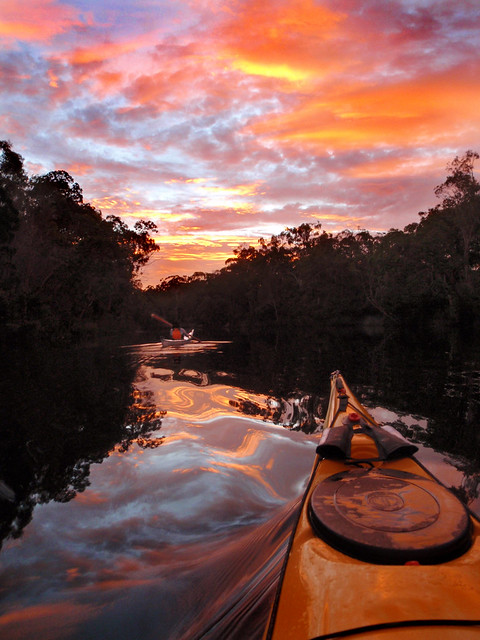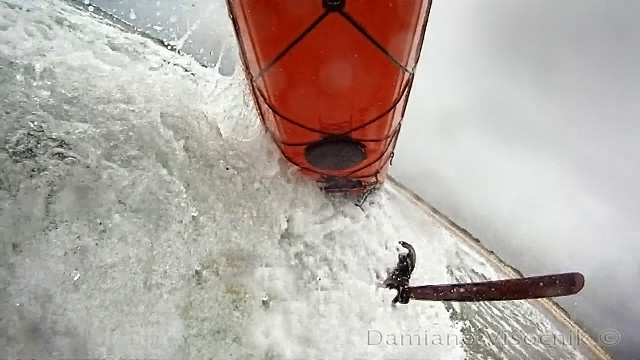After a couple of weeks of getting accustomed to a new style of kayak I finally had the opportunity to take the Zegul 520 HV into some breaking surf.
This kayak performs a bit differently than a fish-form British style one and I find it harder to surf than my other kayaks.
After a few minor modifications (replaced the seat and moved it forward) I have finally the kayak to suit my needs and skills.
The first outing in the surf was a bit sketchy and I was surprised to get spun around so easily and surfed backwards (at: 2:47).
The low rear deck allows me to perform easy layback rolls without having to lift myself from the seat and bend my back too much.
Otherwise I found the Zegul not as maneuverable as some other high volume kayaks of mine.
The Zegul seems to track well for me (heavy person) but the extended keel line doesn't release for easy turning unless edged very aggressively.
The combination of low rear deck, narrow beam and rather high front deck makes this kayak very easy to roll.
The Zegul 520 is a combination of slightly Swede form hull, with decent rocker, partial hard chines (rounded off at bow and stern) rather full bow and somehow close in form to a Greenland style kayak.
For readers seeking a comparison, my personal dimensions: 184cm (6'1") 110Kg (240Lbs), size 38 butt, 35" inseam (88cm), size 12 (US) 46 (EU) shoes.
30 March 2011
29 March 2011
20 March 2011
15 March 2011
TECHNIQUE: riding wind waves
When the weather forecast is a Strong Wind Warning I usually have to amend my weekend paddling plans. While some sheltered areas of Moreton Bay might never experience those predicted high winds I am usually not that fond of paddling in sheltered mangrove cluttered shores.
I don't have the skills nor the desire the be pushing into the wind for hours to complete a long crossing but I still want to paddle.
When the local wind gauges read around 25-35 knots I know that I can still safely paddle in locations on the bay with onshore winds. If wind direction is right, I try to pick an area where the tidal flow will create opposing forces and possibly small standing waves that can be surfed in a sea kayak.
There is a difference between ocean swell and wind waves. Ocean waves tend to have longer faces while wind waves tend to be faster and closely spaced together with a shallower through. Some kayaks with a long hull that don't have a lot of volume in the bow and too little rocker in the keel tend to bury the nose a bit when faced with tidal/wind waves. I found that the best suited kayaks for those conditions are short fish-form hulls where maneuverability prevails over cruising speed.
The latest addition to my fleet, despite not intended as a cruising kayak, has a hard chined hull of slight swede form that requires more attention to surf successfully. I find that, if to be kept on track, I have to work harder on my skills than, let's say, in my high volume bow Mockpool.
It appears that most Valley sea kayaks (not the Rapier) seem to excel in those conditions while higher speed hull boats (longer) don't exactly shine there.
To catch the fast waves I have to time my acceleration carefully. The fist wave in the set helps me to get speed (at 1:45) but I usually can't ride it. The second wave, which follows very closely, needs to be caught with the maximum exertion from my strokes.
It is possible that paddling with traditional paddles requires a modified technique than using a Euro blade. I also tend to give myself a final push with the jolt of my body (at 2:28) to be able to catch some waves that otherwise I would not have the speed to propel myself along the face of it.
A few hours trying to ride short tidal wind waves usually leaves me tired enough to call it a day.
Riding waves is probably the only situation that leaves me anaerobic when sea kayaking. Since I don't really enjoy a fast paced sprint paddle on flat water, I regard sea kayak surfing a real exercise that pushes me physically. I just wish I would do it more often.
I don't have the skills nor the desire the be pushing into the wind for hours to complete a long crossing but I still want to paddle.
When the local wind gauges read around 25-35 knots I know that I can still safely paddle in locations on the bay with onshore winds. If wind direction is right, I try to pick an area where the tidal flow will create opposing forces and possibly small standing waves that can be surfed in a sea kayak.
There is a difference between ocean swell and wind waves. Ocean waves tend to have longer faces while wind waves tend to be faster and closely spaced together with a shallower through. Some kayaks with a long hull that don't have a lot of volume in the bow and too little rocker in the keel tend to bury the nose a bit when faced with tidal/wind waves. I found that the best suited kayaks for those conditions are short fish-form hulls where maneuverability prevails over cruising speed.
The latest addition to my fleet, despite not intended as a cruising kayak, has a hard chined hull of slight swede form that requires more attention to surf successfully. I find that, if to be kept on track, I have to work harder on my skills than, let's say, in my high volume bow Mockpool.
It appears that most Valley sea kayaks (not the Rapier) seem to excel in those conditions while higher speed hull boats (longer) don't exactly shine there.
To catch the fast waves I have to time my acceleration carefully. The fist wave in the set helps me to get speed (at 1:45) but I usually can't ride it. The second wave, which follows very closely, needs to be caught with the maximum exertion from my strokes.
It is possible that paddling with traditional paddles requires a modified technique than using a Euro blade. I also tend to give myself a final push with the jolt of my body (at 2:28) to be able to catch some waves that otherwise I would not have the speed to propel myself along the face of it.
A few hours trying to ride short tidal wind waves usually leaves me tired enough to call it a day.
Riding waves is probably the only situation that leaves me anaerobic when sea kayaking. Since I don't really enjoy a fast paced sprint paddle on flat water, I regard sea kayak surfing a real exercise that pushes me physically. I just wish I would do it more often.
09 March 2011
08 March 2011
REVIEW: comparison Zegul Baidarka and Tahe Reval

Two expedition worthy kayaks from Tahe Marine.
Tahe Marine has recently brought on the market a new style of kayak: the Zegul Baidarka.
I wanted to compare it to the other big loader: the Reval. (Zegul is to Tahe what Lexus is to Toyota).

two very different stern styles
The view of these sterns is compelling: there couldn't be two kayaks more different.
The Reval has a typically British style up swept stern while the Baidarka..., well, there is no other kayak like it. (correction 01JUL11. Nick Shade has a valid argument; see comments)
A traditional Baidarka of the Aleut islands has a different stern than the interpretation of the Zegul.
The Reval has a decent rocker while the Baidarka has very little. Despite the low stern the Baidarka paddled OK in reverse and didn't seem to dig in below the surface.

Stern low in the water. The Aleut paddle seemed very apt for this test paddle
The bow of the Baidarka is just as unique as its stern. A very fine low volume end that up sweeps to a unique horn-like shape. What is missing from a traditional Baidarka is the bifurcated bow, but I guess that would be too much for most to take in :-)
The hull is in epoxy infused carbon/aramide core reinforced construction making it a rather stiff hull.
The kayak is large, there is no denial. The hatch spaces are huge and would swallow an insane amount of gear.
Despite the size of the kayak (of strong swede form) it appeared to cruise at 8 kph with little effort.
The cockpit coaming sits high and there is plenty of room even for the chunkiest legs to fit under the thigh braces of the keyhole cockpit. Large feet also have no problems fitting on the easily adjusted foot pegs.
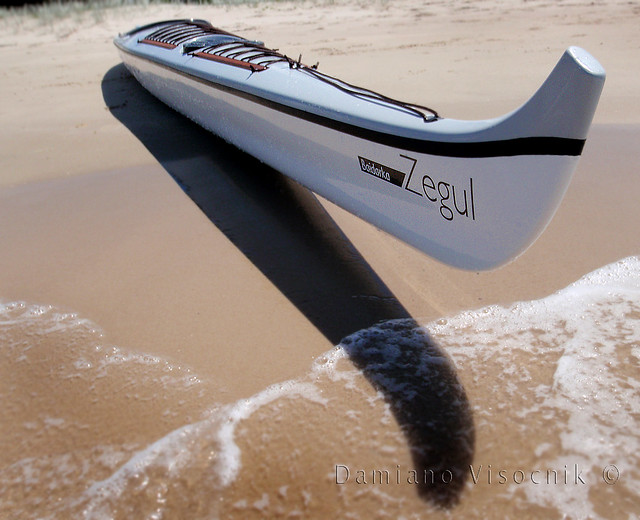
interesting bow, to say the least
The Baidarka has a unique way of lashing the generous deck bungee cords: a section of teak timber provides the anchor point. There is plenty of room to stash your gear on deck.
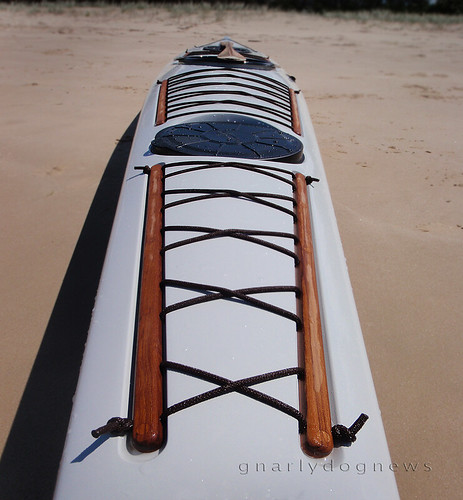
a fantastic finish of the deck's bungees
The Baidarka rolls easily thanks to the positive thigh braces however low laybacks are hindered by the rather high rear coaming.
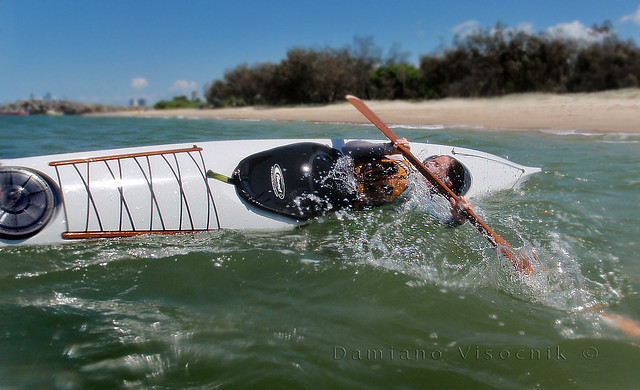
high brace with Aleut paddle.
The Reval is Tahe's other rudderless big-boat offering.
It has strong British style influence with a more chiseled deck look.
The cockpit has again plenty of room for large paddlers while still suited for lighter bodies. It is however not a low volume kayak. Maneuverability seemed very quick despite the size. I felt that the pronounced V shape of the keel line makes the kayak a bit tender on the primary stability. When sitting on the beach it leans to one side however the kayak felt solid when paddled. It tracked well for a rockered boat and was easily turned if edged. Weight didn't seem to slow down either kayak.
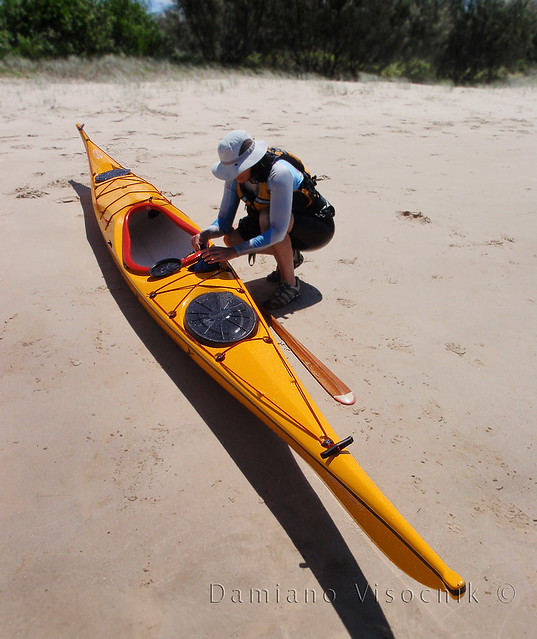
The deck has an indent for (surface) mounting a compass forward of the front hatch.
The bow and stern have a funny shape. Initially I thought it was rather bizarre but as soon as I grabbed the kayak to carry it to the beach I realized the reason for it: it sits very well in the hand and prevents slippage. A nice little touch. The seam tape on the Reval and Baidarka is 1/2" black aramide with no gelcoat cover. It looks very neat with a perfect finish.
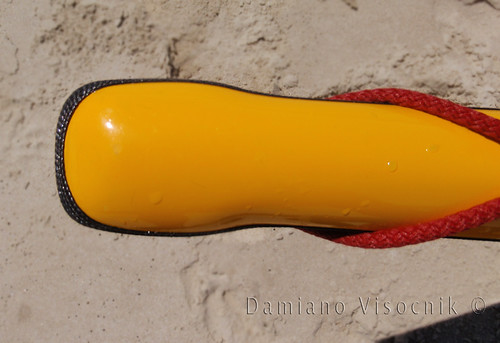
The skeg slider on the Tahes is superb: it slid smoothly and didn't seem to have any drag. A welcome discovery after seeing (and repairing) a few dodgy skegs on other branded kayaks.
Deploying the skeg made a strong effect on the kayak behavior and would correct the slight tendency to weathercock.
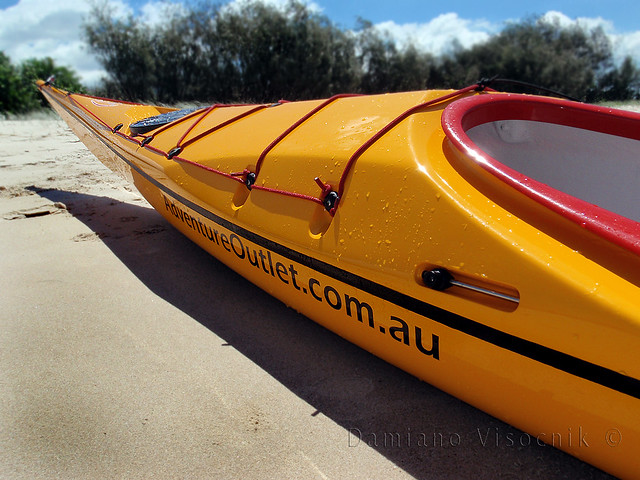
The cut-away on the deck next to the cockpit offers a paddle reach close to the hull for high angle paddling.
The cockpit has a positive space for my thighs (not just resting on little wings) and bracing in the Reval was great. The kayak rolled extremely easily for me and a fair degree of layback was possible.
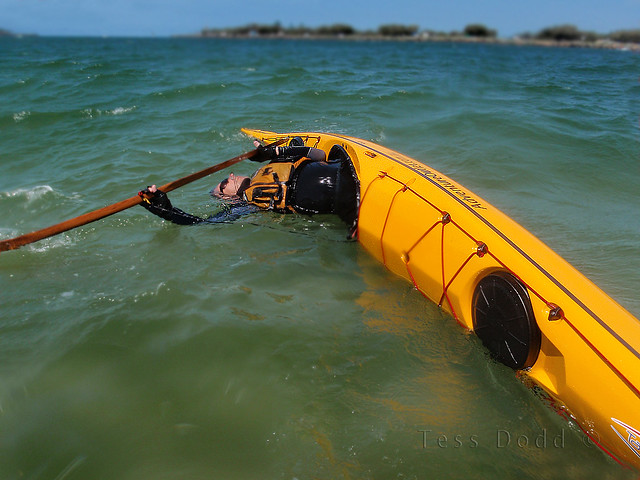
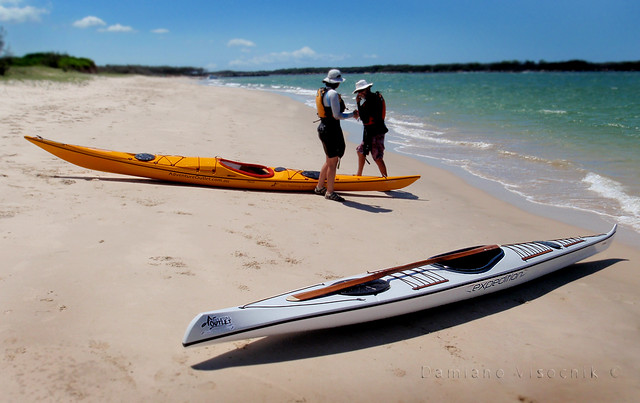
Test paddle conditions;
We loaded the kayaks with about 45 Kg alternatively. They were both paddled loaded and unloaded.
Test paddlers were of mid to heavy weight (68 to 110Kg) and mid to tall height (175 to 184cm)
There was an average of 8-10 knots of wind (gusting to 15kn) and there was 1-2 knots of tidal flow in some spots. The small wind waves were little indication on how the two boats would perform in following seas.
Only an extensive test paddle over several days would give us a better understanding on the kayaks' performance therefore any firm opinions on these kayaks ability are abstained.
This review's aim is to depict the two new kayaks since public images are very hard to come by.
Test kayaks were supplied by Adventure Outlet.
01 March 2011
TECHNIQUE: reenter and roll
As my paddling skills advanced my kayaks reduced their beam.
My first boats sported a hefty beam of 62 cm (24"!). These days I mainly paddle kayaks 53 cm (21") wide.
As the width decreased the "tippiness" increased and that started to challenge some of my skills.
While I feel that most kayaks are rather stable when under way I have trouble keeping a kayak stable without having a paddle in my hand. I often take photographs from the cockpit but rarely in calm waters. A boat that does have weak initial stability is sometimes a challenge to keep upright, if I can't hold my paddle.
Consequently my self rescue technique also had to be reexamined.
I can no longer do the "cowboy" recovery when going for a swim. An assisted rescue is necessary if I want to keep the boat upright when reentering it.
Once I learned to roll proficiently, the most efficient self recovery for me is a reenter and roll.
A straight R&R had not been a problem in my beamy Impex Assateague. I would roll back up and empty the flooded cockpit with my electric bilge pump. While the pump was doing its work I would reattach my spray skirt.
Not so in my narrow beam kayaks. Once the cockpit is flooded the boat becomes more unstable to the point that a paddle is necessary to keep myself upright in textured water.
So, if I am recovering with a R&R I have little chance of putting the skirt back in place since I use both hands to do it and I have to let go of the paddle.
I found out that a reenter, skirt attachment underwater and roll was my best solution.
After a few practice runs I improved the technique.
As I roll back up, I now just switch on my pump and brace for a few minutes until the cockpit is empty again.
Sure we all claim to have "bombproof" rolls and a wet exit is not an option but I still manage to take a swim every so often :-)
My first boats sported a hefty beam of 62 cm (24"!). These days I mainly paddle kayaks 53 cm (21") wide.
As the width decreased the "tippiness" increased and that started to challenge some of my skills.
While I feel that most kayaks are rather stable when under way I have trouble keeping a kayak stable without having a paddle in my hand. I often take photographs from the cockpit but rarely in calm waters. A boat that does have weak initial stability is sometimes a challenge to keep upright, if I can't hold my paddle.
Consequently my self rescue technique also had to be reexamined.
I can no longer do the "cowboy" recovery when going for a swim. An assisted rescue is necessary if I want to keep the boat upright when reentering it.
Once I learned to roll proficiently, the most efficient self recovery for me is a reenter and roll.
A straight R&R had not been a problem in my beamy Impex Assateague. I would roll back up and empty the flooded cockpit with my electric bilge pump. While the pump was doing its work I would reattach my spray skirt.
Not so in my narrow beam kayaks. Once the cockpit is flooded the boat becomes more unstable to the point that a paddle is necessary to keep myself upright in textured water.
So, if I am recovering with a R&R I have little chance of putting the skirt back in place since I use both hands to do it and I have to let go of the paddle.
I found out that a reenter, skirt attachment underwater and roll was my best solution.
After a few practice runs I improved the technique.
As I roll back up, I now just switch on my pump and brace for a few minutes until the cockpit is empty again.
Sure we all claim to have "bombproof" rolls and a wet exit is not an option but I still manage to take a swim every so often :-)

